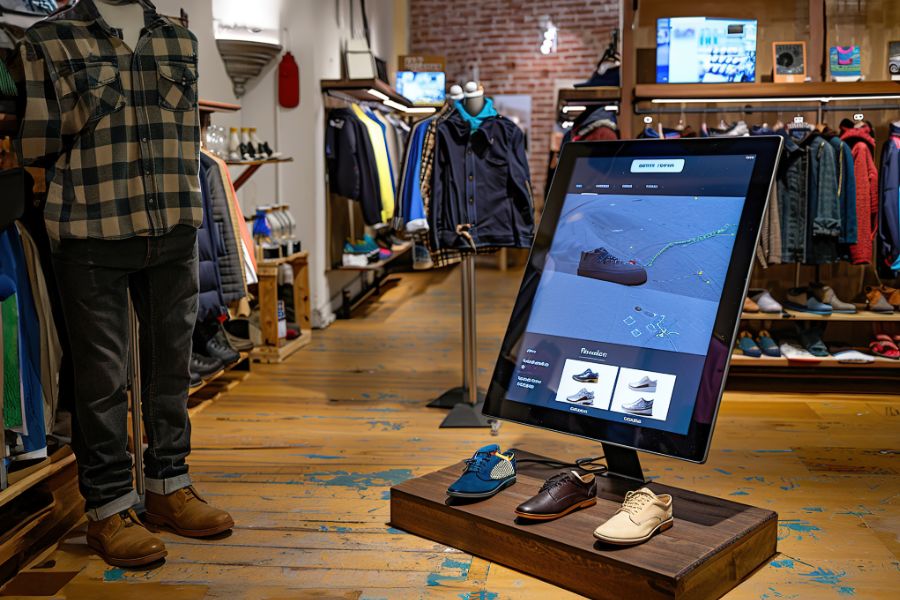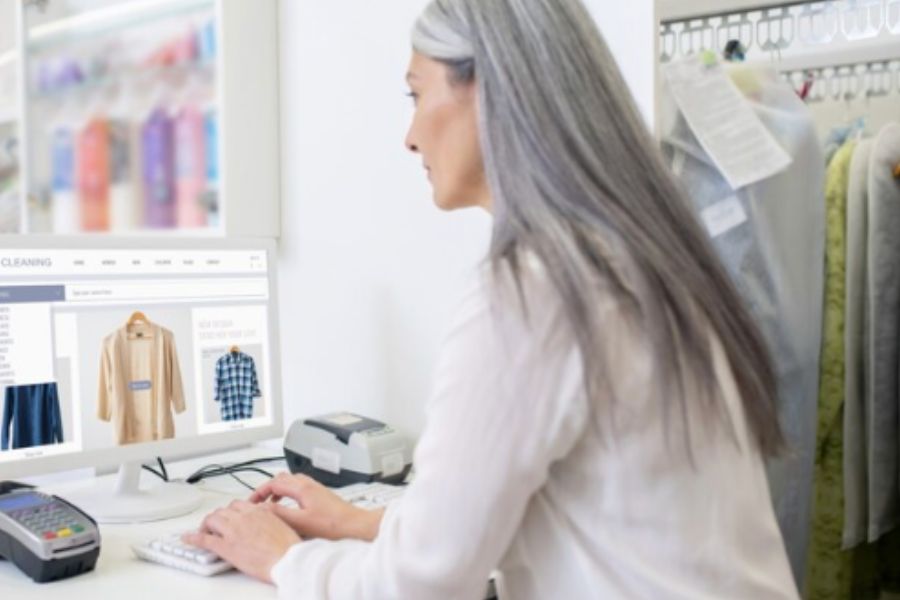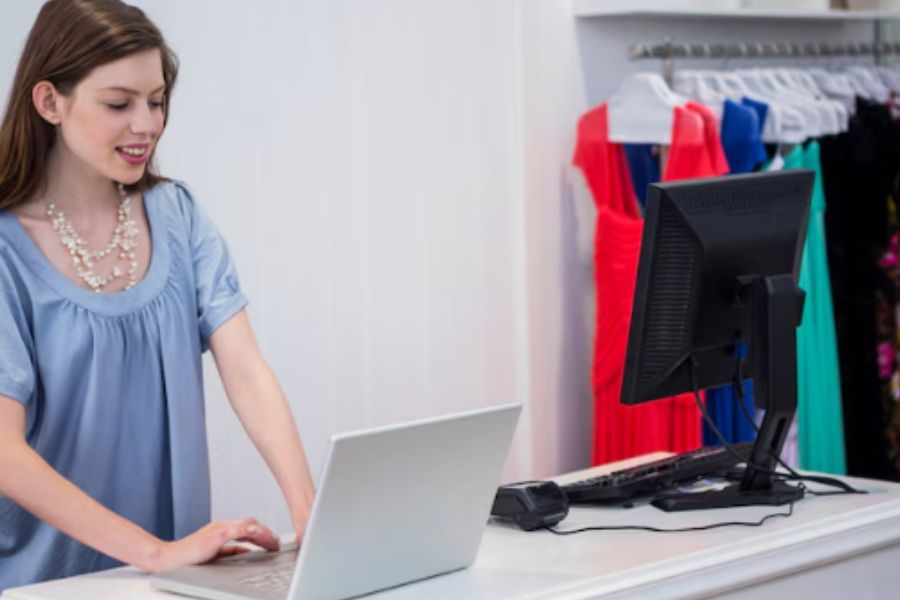If you own or manage a footwear store, you know how important it is to have a reliable and efficient point of sale (POS) system. As technology continues to advance, there are new and innovative POS software trends emerging in the market that can help streamline your operations, enhance customer experience, and boost your bottom line. In this article, we will explore six revolutionizing trends in POS software footwear that you shouldn’t miss out on. Whether you’re just starting out or looking to upgrade your current system, these trends are worth considering to stay ahead of the game in the competitive footwear industry.
What is POS Software Footwear?
POS software footwear, or footwear POS software, is a type of retail management software designed specifically for footwear stores. It streamlines various aspects of running a footwear business, from managing inventory to processing sales transactions.
Footwear POS software typically includes the following features:
- Inventory management: This feature allows footwear retailers to track their inventory accurately, including different sizes, styles, and colors of shoes. It helps in avoiding stockouts and overstock situations, ensuring that customers can always find the products they need.
- Size and style matrix: Footwear stores often carry the same style of shoe in multiple sizes and colors. A size and style matrix feature allows retailers to manage these variations efficiently, making it easier for customers to find the right fit.
- Barcode scanning: Barcode scanning capabilities enable quick and accurate processing of sales transactions. Retailers can scan barcodes on shoe boxes or labels to add items to a sale, update inventory levels, and generate receipts automatically.
- Integrated payment processing: Footwear POS software often integrates with various payment processing systems, allowing retailers to accept different payment methods such as cash, credit cards, mobile payments, and gift cards.
- Customer Relationship Management (CRM): CRM functionality helps footwear retailers build and maintain relationships with their customers. It allows them to capture customer information, track purchase history, and send targeted promotions or loyalty rewards.
- Reporting and analytics: Comprehensive reporting and analytics tools provide insights into sales performance, inventory turnover, customer preferences, and more. Retailers can use this data to make informed business decisions and optimize their operations.
Overall, footwear POS software empowers footwear retailers to run their businesses more efficiently, improve customer service, and drive sales growth.
ConnectPOS enhances footwear store operations by tailoring features to industry-specific needs like inventory and style matrix management. It supports barcode scanning and integrates with various payment systems for a seamless checkout experience. Additionally, its CRM capabilities help maintain customer relationships, while comprehensive analytics aid in making informed business decisions.
6 Revolutionzing Trends In POS Software Footwear
The world of footwear retail is constantly evolving, and POS software is crucial in improving productivity and satisfying customers. In this article, we will explore six trends that are transforming POS software in the footwear industry, driving innovation, and enabling retailers to remain competitive.
Mobile payment solutions and tablet-based POS systems
As the shift towards digitalization reshapes the retail landscape, it also challenges the traditional reliance on cash and cash registers. Cash is gradually losing its dominance as the preferred mode of payment, with 73% of respondents in a Mastercard survey indicating that they use cash less frequently now than they did a decade ago.
Leading tech giants like Apple, Samsung, and Google are facilitating mobile payments through smartphones, offering consumers a more convenient payment option. Consequently, traditional cash registers are becoming obsolete.
You can anticipate a growing trend of brick-and-mortar stores adopting tablet-based POS software systems capable of accepting various payment methods, including mobile payments, traditional credit card transactions, and cash. According to a recent survey by ShopKeep, 30% of small business owners desire enhanced functionality beyond what traditional cash registers offer.
Cloud-based technology
Cloud-based POS systems have gained widespread adoption among footwear retailers due to their scalability, accessibility, and cost-effectiveness. More than 50% of retailers have adopted cloud-based POS solutions, which is hardly surprising given that nearly all tablet POS software systems operate on the cloud. This means that the POS software, services, and data are delivered to the user on demand from the service provider’s servers. Essentially, the service provider takes care of storing and securing your data, relieving you of the burden.
For most small businesses, investing in network infrastructure poses a significant financial challenge. However, cloud technology and the rise of as-a-service business models have synergized to dramatically reduce the cost barrier to accessing technology that was previously only accessible to large enterprises just a few years ago.
For instance, a footwear chain can synchronize inventory levels seamlessly across its stores through a centralized cloud-based POS system, ensuring optimal stock levels and reducing the risk of overstock or stockouts.
Automated processes
In 2024, another critical area where retailers need to increase investments is automation, which involves leveraging technology to carry out repetitive tasks with minimal human involvement. The persistent labor shortages have underscored the importance of automation across various facets of the retail industry, spanning from warehousing, inventory management, and order fulfillment to customer-facing functionalities like contactless payments, as highlighted by Gabriella Bock.
According to McKinsey, 52% of retail activities can be automated using existing technology. Automation reduces human errors, enhances the quality and speed of service, elevates employee productivity, and leads to cost savings. For retailers grappling with margin pressures, automation can yield 300 to 500 basis points of incremental margin, making it not just an option but a necessity in the fiercely competitive retail landscape.
Data analysis and insights
Data analysis tools integrated into POS software provide footwear retailers with valuable insights into customer preferences, buying patterns, and trends. Entrepreneurs and small business owners seek rapid access to data and analytics to aid in making informed, data-driven decisions for their businesses. In the same ShopKeep survey, 50% of respondents highlighted the importance of access to reporting as a crucial factor influencing their ongoing use of their POS systems.
As mentioned above, the utilization of cloud technology and an innovative business model has helped bridge the gap between the type of data once exclusively available to large enterprises and what small businesses now possess in their toolkit.
Effective POS software should not only provide snapshots of key business metrics such as sales revenue or transaction volume but should also delve deeper into the timing of these transactions. For instance, identifying peak hours allows for appropriate staffing levels. Similarly, it should offer insights into product performance, distinguishing between top-selling items and those that linger on the shelves for extended periods, thus preventing the tie-up of valuable cash flow in underperforming products.
AI-driven functionalities
Artificial Intelligence (AI) is revolutionizing POS software by enabling predictive analytics, personalized recommendations, and intelligent automation. AI-powered algorithms can analyze vast amounts of data to forecast demand, optimize pricing, and recommend products tailored to individual customer preferences.
For example, a footwear retailer can leverage AI-driven POS software to suggest complementary items based on past purchases or recommend the perfect pair of shoes based on a customer’s style preferences and foot measurements.
Smooth and highly customized customer shopping experiences
The deeper a business understands its customers, the better it can tailor their shopping experiences. According to a survey of 2,200 consumers, 78.6% expressed a preference for engaging with brands offering personalized promotional offers based on their past interactions. Consumers are not receptive to generic advertising messages; in fact, 63% of respondents find continuous generic advertising highly irritating.
Adopting a hyper-personalized marketing approach is essential to attract new customers and foster loyalty among existing ones. Artificial intelligence emerges as a valuable tool in achieving this goal. Creating a personalized shopping experience also involves ensuring a seamless customer journey. Customers expect consistency across all channels and touchpoints of your business, often referred to as omnichannel experience, a popular term in contemporary marketing discourse.
FAQs: POS Software Footwear
- Is POS software footwear only suitable for large retailers?
No, POS software footwear can benefit footwear retailers of all sizes, from small boutique shops to large chains. It provides essential tools for managing inventory, processing transactions, and analyzing sales data, which are valuable for any business in the footwear industry.
- How does AI help in inventory management for footwear stores?
AI can significantly enhance inventory management for footwear stores by analyzing historical sales data, predicting demand, and optimizing stock levels. AI-powered algorithms can identify trends and patterns in customer purchasing behavior, helping retailers make informed decisions about stocking popular items and reducing the excess inventory of slow-moving products.
- Are contactless payments secure for footwear businesses?
Yes, contactless payments are generally considered secure for footwear businesses. Contactless payment methods, such as tap-to-pay with credit cards or mobile wallets like Apple Pay and Google Pay, use encryption and tokenization technologies to protect sensitive payment information. Additionally, these transactions often have lower fraud rates compared to traditional payment methods like cash or magnetic stripe cards.
- Can POS software help footwear retailers improve customer loyalty?
Yes, POS software can play a crucial role in improving customer loyalty for footwear retailers. By capturing customer data and purchase history, POS systems enable retailers to implement loyalty programs, offer personalized promotions, and provide better customer service. Additionally, POS software can facilitate smooth transactions and checkout experiences, enhancing overall customer satisfaction and loyalty.
Conclusion
In sum, these POS software footwear trends underscore the importance of leveraging technology to meet the evolving needs of footwear retail businesses, from streamlining operations to enhancing customer satisfaction. By staying abreast of these trends, retailers can position themselves for success in a dynamic and competitive market. If your business needs POS software, ConnectPOS is the best option with advanced features and support. Contact us for more information!



